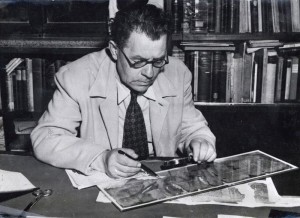Sukenik and the Dead Sea Scrolls, Part II
The Non-Biblical Scrolls
Regarding the non-biblical scrolls, in this early use of the War Scroll and the Hodayot that were in his possession, but also the Pesher Habakkuk and Rule of the Community that he had seen but not been able to purchase, he recognized that previously unknown texts provided an entrée to understanding the religious lifeof the last two centuries B.C.E. He saw Pesher Habakkuk as showing the antiquity of midrashic literature among the Jews, although he later clarified this position. Sukenik recognized the script of the scrolls from various tombs that had been found in an area of Jerusalem. This, in fact, is how he dated the scrolls. (He saw as especially close the Uzziah inscription that he had himself discovered.) He also noted the peculiar spelling system of the scrolls, which he saw as dating to this early date.
Sukenik also pointed to earlier discoveries in the same area. In 1917 there had been a discovery of Hebrew and Greek biblical manuscripts hidden in dry vessels, including in one report, a Greek Psalm text used by Origen in the Hexapla.
Sukenik concluded his general discussion in Sekirah Aleph by being as far as I know the first to suggest, based on his inspection of the Rule of the Community (1QS), that these texts had belonged to the Essenes who had lived on the western shore of the Dead Sea “near Ein Gedi,” in his words.
By the time his Sekirah Bet was published in 1950, he knew much more about the scrolls, both those in Israeli hands and also those in the hands of others. In the interim, the “genizah” cave had been found and some had even tried to dispute the antiquity of the scrolls. The date was now firm in the light of the finding of additional manuscript fragments scattered among pottery definitely dated to the late Hellenistic period. In the second volume he published several texts and even improved photos of texts he had previously published. Here he already noted that Isaiah B, in Israeli possession, was closer to Masoretic Text than Isaiah A, in the hands of Athanasius Samuel. (His thanks to John Trever and R. de Vaux for their help bespeak a level of cooperation that does not seem to have continued.) In the introduction to this volume he began by telling the familiar story of the discovery of the scrolls, including some otherwise unknown specifics regarding the abortive involvement of the Hebrew University, as well as his own involvement. He also gave a full account of the then know archaeological data. He stated that the pottery proved that the scrolls had been hidden in the cave (he only had one cave) no later than the 1st century B.C.E.


i am here at university college,falmouth,uk,whilst the annual vacation of hasidic jews takes place-it’s wonderful!it is so important not to forget the contribution of pioneers like sukenik and co. who blazed the trail of dss studies.
Dear Dr Peter Long
Are you aware of King’s Calendar in the Damascus Rule as stated that the Babylonian destroyed the temple in 586 BCE.
Please note
Josephus relied heavily upon the Essenes, and in his reference to Aristobolus, he used the same artificial code/calendar as appears in the Damascus Rule, ‘Age of Wrath’.
source of that code was the Essene/Dead Sea Sect Community.
Is the mention of 1917 a typo (and was the find related by Origen and others earlier)?
(sorry if this message is in all capital letters; It appears in all caps even though I do not have caps lock on)
Attention; Stephen Goranson
I am replying to your Question about a typo and related by Origen and others.
Can I mind you in your response about your proposal the Teacher of Righteousness and others there is a great scholar you might interested in R.P. Ben Dedek apparently he studied the King’s Calendar: Secret of Qumran .
He described the Dead Sea Scrolls with Essenes usuing a method which he calls Biblical Synchronous Chronology and it’s Scriptural Transmission and transcription of the Artificial Calendar.
He is tagging with Dead Sea Sect, Essenes and Qumran Community.
Many thanks
John Stuart
For 1917 (above) read 217.
Attention Stephen Goranson
Do you have any information on Simon III?
In response about the Osei Ha Torah problem that you questioned.
I have the answer the Sons of Zadok known as Kodesh Shonim the term for OSei Ha-Torah they observed the Doers of the Torah.
from
John Stuart